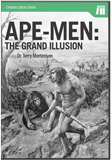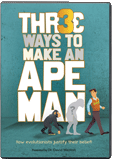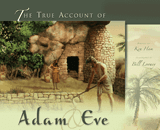In Defense of the Historical Adam
The cover story in Christianity Today in June 2011 was “The Search for the Historical Adam.” The subtitle read, “Some scholars believe genome science casts doubt on the existence of the first man and woman. Others say the integrity of the faith requires it.” The number of professing evangelical scholars doubting or denying a literal Adam and Eve has continued to grow.
Some say the account of Adam and Eve is a myth, a symbolic story to teach us theological and moral truth. Others say that Adam and Eve were the first two humans but that they evolved from ape-like creatures and became human when God breathed into them. Others say they really existed but that Adam was merely the head of a clan or tribe: Adam and Eve weren’t the only humans at that time but were chosen by God for His purposes. Still others take Genesis 1–3 as literal history: the first man Adam was made from dust and the first woman Eve was made from his rib.
So what is the truth and does it really matter anyway, as long as you believe in Jesus Christ as your Lord and Savior? Good question. Let’s see what God’s inerrant Word says.
The Historicity of Adam
The historicity of Adam is abundantly clear from both the Old and New Testaments. Right from the beginning, the text describes real time and names people and places. Genesis 1 speaks of years and seasons and days with evenings and mornings governed by the sun, moon, and stars. Genesis 2 describes the location of the Garden of Eden and names four rivers. Genesis 4 names the city that Cain built. Genesis 6–8 describes certain events on specific days of different months of the 600th and 601st years of Noah’s life. The eleven occurrences of the Hebrew word toledoth scattered through Genesis (in Genesis 2:4, 5:1, 6:9, 10:1, and so on) and translated as “this the account of” or “these are the generations of” tie the whole book together as one historical record. Few evangelicals doubt the historicity of Genesis 12–50, but there is no break in the literary style between chapters Genesis 11 and Genesis 12. The Abraham and Terah of Genesis 11 are the same men in Genesis 12. The genealogies of Genesis 5 and Genesis 11 connect Adam to Noah to Abraham so that all of the men named were equally historical. The Hebrew verb forms in Genesis 1, which is often claimed to be a unique genre, show conclusively that the first chapter of the Bible is historical narrative just like the rest of Genesis.1
Outside of Genesis, the genealogies of 1 Chronicles 1:1–9:44 show that the ancestries of the tribes of Israel go back to Abraham and then to Adam. Luke 3:23–38 traces the lineage of Jesus back through David and Abraham to Adam. All those named in Jesus’ genealogy must be real historical people or else Jesus is descended from a metaphor or myth. Paul treats as historical fact that Adam brought sin and death into the world (Romans 5:12; 1 Corinthians 15:21–22) and that Eve was created from Adam and was deceived by Satan (1 Corinthians 11:8–9; 2 Corinthians 11:3; 1 Timothy 2:13–14). Although John and Peter don’t mention Adam or Eve directly, John refers to Cain’s murder of Abel as historical (1 John 3:11–12). And Peter believed that the account of the Flood was just as historical as the account of the judgment of Sodom and Gomorrah, even emphasizing that only eight people were saved in the Ark (1 Peter 3:20; 2 Peter 2:4–9), and that people who deny the Second Coming and the Flood and Creation are deliberate scoffers (2 Peter 3:3–7). Jude says that Enoch was in the seventh generation after Adam (Jude 14).
Jesus certainly believed that Noah, the Ark, and the Flood were historical (Matthew 24:37–39), as were the accounts of the murder of Abel (Luke 11:50–51) and the transformation of Lot’s wife into salt (Luke 17:28–32). Quoting from Genesis 1–2 as historical fact, Jesus insisted that God created marriage to be a lifelong commitment between one man and one woman (Matthew 19:3–6).
There is no question that the biblical writers and Jesus took Genesis 1–11 as straightforward history and that Moses intended it to be understood that way.2
So Adam and Eve were literal, historical people who literally fell in sin in the Garden of Eden after Eve listened to the deceiving words of the serpent. But that is not all that we must affirm if we are faithful to God’s Word.
The Uniqueness of Adam
Scripture is crystal clear that Adam was the first man (1 Corinthians 15:45) and that Eve was the first woman, the mother of the human race (Genesis 3:20). There were no humans before them. God is also clear that He created Adam and Eve supernaturally. In Genesis 1 there is a clear distinction between the supernatural creation of the first plants, animals, and man and woman (by God’s Word: “let there be . . .”) and the natural procreation of all the subsequent plants, animals and people (from the “seed” in the first creatures as they were fruitful and multiplied).
The Bible also absolutely rules out the idea that Adam and Eve’s bodies evolved from some pre-existing ape-like creature. In Genesis 1 the first two humans were made distinct from the plants and land, sea, and flying creatures. They were all intended and designed to reproduce “after their kind,” not to change from one kind to another kind. So mankind was categorically distinct.
Genesis 2:7 informs us that God made Adam from dust, breathed into his nostrils the breath of life, and he became a “living being.”3 These two words are a translation of the Hebrew nephesh chayyah. Those same two Hebrew words are used in Genesis 1:21, 24, 30; 2:19; and 9:10 to describe sea creatures, land animals, and birds. They also are living beings, though they are not made in the image of God. So God did not make a living creature, breathe into it, and transform it into man. God did not make Adam from a pre-existing living creature.
In contrast, Genesis 2:22 tells us that Eve was made from a pre-existing living creature: Adam. But there is no legitimate way to interpret “from his rib” to mean “from a pre-existing hominid distinct from Adam.” This verse cannot possibly be harmonized with the evolution story without doing great violence to the text. It describes supernatural surgery.
Scripture could not be clearer: God did not use evolution to create Adam and Eve from some ape-like ancestors.
Not only does the Bible teach us that Adam and Eve were supernaturally created as the first two humans who rebelled against God resulting in death. This has also been orthodox Christian teaching from the beginning of the church, as William VanDoodewaard has demonstrated.4
The Recent Creation of Adam at the Beginning of Creation
The Bible also makes it clear that Adam was created on the sixth literal day of history. Exodus 20:8–11 says that God created heaven, Earth, and the seas, and all that is in them in six days, the very same kind of days as in a human workweek. God didn’t create anything before the six days because those days began in Genesis 1:1.
Jesus understood Genesis this way. In Mark 10:6 and 13:19 He reveals His belief that Adam and Eve were at the beginning of creation, not billions of years after the beginning, as in an evolutionary view.5 Paul believed the same, for in Romans 1:20 he says that people have seen the witness of the creation to the existence and nature of the Creator “since the creation of the world.” This only makes sense if Adam were created on the sixth day of Creation Week.
The Bible also teaches that death, disease, and other natural evils were brought into the original “very good” creation when God cursed the creation because of Adam’s rebellion. Therefore the geological record of rock layers and fossils cannot represent an earth history of hundreds of millions of years before man, as evolutionists assert.6 Furthermore, if there really were millions of years before Adam, then most of the animals lived and died before Adam and Eve could rule over them, as God commanded (Genesis 1:26), and for most of their existence the sun, moon, and stars could not serve one of the three divine purposes for which they were created: for man to tell time (as well as for dividing night and day and for giving light on the Earth; Genesis 1:14).
Literal Adam: Essential to the Gospel
The Apostle Paul inseparably connects Jesus to Adam. Jesus came to rectify the damage done by Adam (Romans 5:12–19; 1 Corinthians 15:21–22 and 1 Corinthians 15:45). Adam brought sin and death into the world; Jesus brought righteousness and life into the world. The good news of the gospel cannot be properly understood without understanding the bad news of Genesis 3. We are all sinners in need of a Savior because we inherited our sin nature from Adam and have rebelled against God just as he did.
No Adam: no gospel. If Adam and the Fall are not historical, then Jesus died for a mythological problem and He is a mythological savior offering us a mythological hope. The American Atheists understand this better than many Christians:
No Adam and Eve means no need for a savior. It also means that the Bible cannot be trusted as a source of unambiguous, literal truth. It is completely unreliable, because it all begins with a myth, and builds on that as a basis. No fall of man means no need for atonement and no need for a redeemer.7
Some professing Christians are beginning to reason in a similar way and radically change the meaning of the death of Jesus.8 Physicist Karl Giberson, a prominent theistic evolutionist and past Executive VP for BioLogos, recently wrote the following:
The challenge of taking “God’s Two Books” (nature and the Bible)9 seriously has grown dramatically in recent years as genetic evidence has made it clear that Adam and Eve cannot have been historical figures, at least as described in the Bible. More scientifically informed evangelicals within conservative traditions are admitting that the evidence is undermining Creation-Fall-Redemption theology.10
Although not stated, what Giberson surely has in mind is the evolutionist claim that scientists have proven that the genomes of chimpanzees and humans are 96–98% identical and that chimp chromosomes 2A and 2B fused end-to-end to form human chromosome 2, confirming evolution. Both of these claims have been thoroughly refuted by PhD geneticist Jeffrey Tomkins at the Institute for Creation Research.11 The fossil evidence doesn’t support human evolution either. Rather the public is being deceived by assumptions and artistic imagination masquerading as scientific fact.12
As with so many other truths in Genesis 1–11, the denial of a literal Adam is an assault on the authority and inerrancy of the Word of God and therefore a subtle way of calling God a liar. But as Romans 3:4 says, “Let God be true but every man a liar.
” As evidenced by the Supreme Court’s recent decision to legalize same-sex “marriage,” God’s truth is under attack as never before in America. The atheist dogma of evolution and millions of years is the foundation of those attacks and just as Scripture warns repeatedly, those attacks are coming both from those outside the church and from professing Christian leaders inside the church (Acts 20:28–32; 2 Peter 2:1–3).
We must cling to God’s inerrant, authoritative Word and equip ourselves and our children and grandchildren with the apologetic tools to boldly, humbly, and graciously defend the truth and expose the lies and deceptions of nonbelievers and false teachers.
Footnotes
- See chapter 6 in Coming to Grips with Genesis (Green Forest, AR: Master Books, 2008).
- Moses was the human author, writing under divine inspiration, of the whole book of Genesis. See Bodie Hodge and Terry Mortenson, “Did Moses Write Genesis?,” Answers in Genesis, June 28, 2011, https://answersingenesis.org/bible-characters/moses/did-moses-write-genesis/.
- KJV says “living soul.” ESV says “living creature.” NIV, NASB, NKJV and HCSB say “living being.” These are different translations for the same Hebrew words.
- William VanDoodewaard, The Quest for the Historical Adam (Grand Rapids, MI: Reformation Heritage Books, 2015).
- For a short defense of this statement see Terry Mortenson, “But from the Beginning of . . . the Institution of Marriage?,” Answers in Genesis, November 1, 2004, https://answersingenesis.org/family/marriage/but-from-the-beginning-of-the-institution-of-marriage/. For a more in-depth discussion see chapter 12 in Coming to Grips with Genesis.
- See Terry Mortenson, “The Fall and the Problem of Millions of Years of Natural Evil,” Answers in Genesis, July 18, 2012, https://answersingenesis.org/theory-of-evolution/millions-of-years/the-fall-and-the-problem-of-millions-of-years-of-natural-evil/.
- American Atheists, “You KNOW it’s a Myth: This Season, Celebrate REASON!,” quoted in “I Agree with the Atheists!,”Around the World with Ken Ham (blog), June 1, 2011, https://answersingenesis.org/blogs/ken-ham/2011/06/01/i-agree-with-the-atheists/.
- E.g., Joseph Bankard, “Substitutionary Atonement and Evolution, Part 1,” BioLogos, June 9, 2015, http://biologos.org//blog/substitutionary-atonement-and-evolution-part-1.
- Nature is not a book. The categorical confusion is clearly addressed in chapter 4 of Coming to Grips with Genesis.
- Karl Giberson, “creating Adam, again and again,” Peter Enns (blog), June 12, 2015, http://www.patheos.com/blogs/peterenns/2015/06/creating-adam-again-and-again/.
- See Jeffrey P. Tomkins, “Comprehensive Analysis of Chimpanzee and Human Chromosomes Reveals Average DNA Similarity of 70%,” Answers Research Journal 6 (2013): 63–69, https://answersingenesis.org/answers/research-journal/v6/comprehensive-analysis-of-chimpanzee-and-human-chromosomes/; and Tomkins, “Alleged Human Chromosome 2 ‘Fusion Site’ Encodes an Active DNA Binding Domain Inside a Complex and Highly Expressed Gene—Negating Fusion,” Answers Research Journal 6 (2013): 367–375, https://answersingenesis.org/genetics/dna-similarities/alleged-human-chromosome-2-fusion-site-encodes-an-active-dna-binding-domain-inside-a-complex-and-hig/. Also see his article on how genomes are sequenced and why it matters: “How Genomes are Sequenced and Why it Matters: Implications for Studies in Comparative Genomics of Humans and Chimpanzees,” Answers Research Journal 4 (2011): 81–88, https://answersingenesis.org/genetics/dna-similarities/how-genomes-are-sequenced-and-why-it-matters/. On the genetics of Neanderthals see David DeWitt, Did Neanderthals and Modern Humans Share a Common Gene Pool? (DVD; Answers in Genesis, 2003).
- See these illustrated DVD lectures: Terry Mortenson, Ape-men: The Grand Illusion (DVD; Answers in Genesis 2012); and David Menton, Three Ways to Make an Ape-Man (DVD; Answers in Genesis, 2014). Also see this small book: A Pocket Guide to Ape-Men (Hebron, KY: Answers in Genesis, 2010).
Recommended Resources

Answers in Genesis is an apologetics ministry, dedicated to helping Christians defend their faith and proclaim the good news of Jesus Christ.
- Customer Service 800.778.3390
- © 2024 Answers in Genesis










